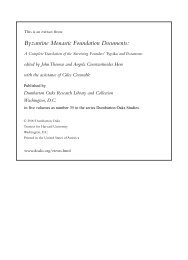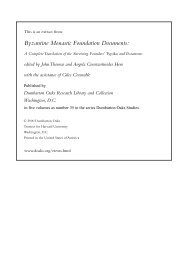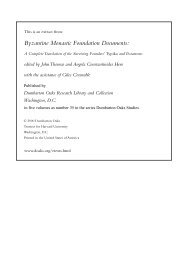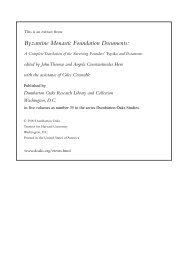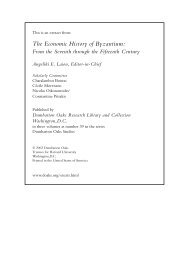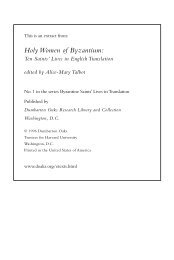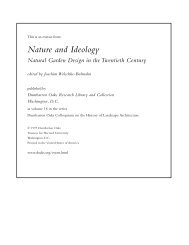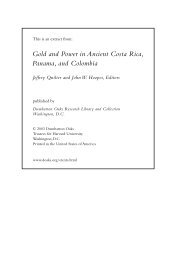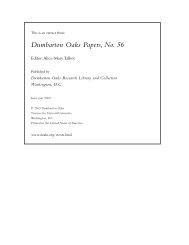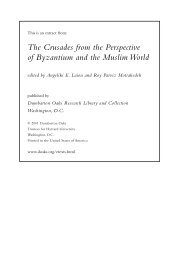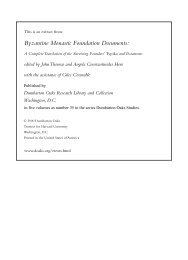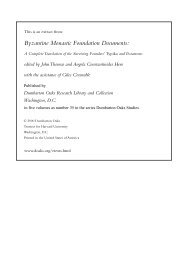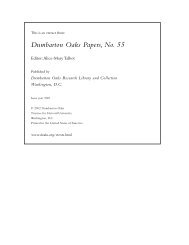The Zooarchaeological Record from Formative ... - Dumbarton Oaks
The Zooarchaeological Record from Formative ... - Dumbarton Oaks
The Zooarchaeological Record from Formative ... - Dumbarton Oaks
Create successful ePaper yourself
Turn your PDF publications into a flip-book with our unique Google optimized e-Paper software.
<strong>The</strong> <strong>Zooarchaeological</strong> <strong>Record</strong> <strong>from</strong> <strong>Formative</strong> Ecuador<br />
area. <strong>The</strong> designations Early, Middle, and Late (see Fig. 1) conform to the Valdivia,<br />
Machalilla, and Chorrera phase cultures, respectively. As some sites are multicomponent<br />
occupations, the total number of chronologically discrete assemblages<br />
examined in this essay is 32.<br />
<strong>The</strong> zooarchaeological database is presented in three tables. Table 1 lists the<br />
invertebrate and principally molluscan fauna recovered <strong>from</strong> <strong>Formative</strong> contexts<br />
mainly in the coastal lowlands. Table 2 lists all of the identified cartilaginous<br />
and bony fishes <strong>from</strong> <strong>Formative</strong> archaeological contexts. Table 3 compiles<br />
similar data for amphibian, reptile, bird, and mammal remains recovered in <strong>Formative</strong><br />
contexts. For ease of presentation, the majority of uncertain identifications<br />
are considered in the next higher taxonomic category (e.g., cf. Rodentia<br />
is considered Rodentia). Where contemporary genera are represented by only<br />
one specific form, that species name is used.<br />
INTERPRETIVE LIMITATIONS OF THE RECORD<br />
To varying degrees, all archaeological samples are temporally and spatially<br />
distanced <strong>from</strong> their parent population. Many processes can subtract <strong>from</strong>, add<br />
to, and/or spatially rearrange an assemblage after it has departed a living context,<br />
is deposited, buried, and eventually excavated, and analyzed. <strong>The</strong>refore, for<br />
purposes of subsistence or paleoecological reconstruction, it is usually difficult<br />
to refer the exact structure of an excavated sample back to its parent population,<br />
our target of interest. Here, I briefly focus on some of the more important<br />
processes that can confound this relationship, emphasizing how they can<br />
potentially affect the qualitative and quantitative structure of an excavated sample.<br />
Some points are obvious, but those that are not are very often subtly pernicious.<br />
Animals differ in both the number and distribution of durable body parts,<br />
and these intrinsic factors alone can strongly influence the presence or absence<br />
and abundance data during each stage of assemblage formation. Certain taxa<br />
have more durable parts that are often identifiable to differing levels of accuracy<br />
when found in isolation. For example, a gastropod has one shell that can<br />
be reliably identified when complete; a fish has hundreds of bony elements,<br />
many of which are difficult to identify when separated <strong>from</strong> the rest of the<br />
skeleton. Moreover, these parts are usually recovered as fragments. Skeletal portions<br />
of diverse taxa—or even different portions of the same skeleton—often<br />
exhibit differential durability. For example, the preservation potential of a discarded<br />
marine oyster shell is unlike that of a digested microvertebrate skeleton,<br />
as is the survivorship of a durable tooth isolated <strong>from</strong> the highly fragmented<br />
skull of a small animal. <strong>The</strong>se variables strongly influence the data presented<br />
177




